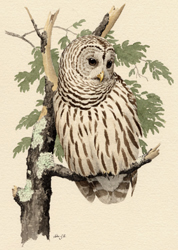Breeding Bird Atlases (BBA)
Find a Bird - BBA1
Breeding Bird Atlas 1 Species Accounts
Barred Owl
Strix varia
Egg Dates
February 25 to May 13
Number of Broods
one; may re-lay if first attempt fails.

The Barred Owl is a resident in much of eastern North America from southern Canada to the Gulf Coast. It was undoubtedly scarcer a century ago when the landscape was extensively cleared for agriculture. In Massachusetts, it is now fairly common in the hill country of the western portions of the state, especially in woodlands near extensive swamps, reservoirs, and Beaver ponds. The species nests more sparsely in the Northeast, and, although it is distributed locally in southeastern Red Cedar and Red Maple swamps, it is extremely rare on Cape Cod and the Islands.
One of the most vocal of owls, the Barred Owl can be heard throughout the year, but, as the breeding season approaches, it intensifies its familiar nine-note serenade, who cooks for you, who cooks for you all? The birds will respond readily to imitations of the calls, even if these are quite rough. In addition to these standard vocalizations, the owls have other calls and sometimes partake in a fervent caterwauling, a series of wild, almost maniacal, hoots and screams, which, once heard, are unforgettable.
Barred Owls construct no nest; rather, a hollow in a large tree or an old crow, hawk, or squirrel nest is chosen, and the same site is often used for several years in succession. Of 38 Massachusetts nests recorded (ACB), 21 were in White Pine, 6 in deciduous woods, and 11 in mixed forest. The nest sites were as follows: 18 old hawk nests, 15 hollow trees, and 5 squirrel nests. Formerly, when the Red-shouldered Hawk was more common, its old nests were often utilized. However, recent nests have generally been located in tree hollows or on stubs of broken trees.
Two or three (rarely four) pure white eggs are laid. Clutch sizes for 38 Massachusetts nests were two eggs (28 nests), three eggs (8 nests), and four eggs (2 nests) (ACB). Incubation, mostly if not entirely by the female, begins with the first egg and lasts 28 to 33 days. Hatching is asynchronous. The young are fed a diet of mice and other small mammals, birds, and to a lesser extent frogs and snakes. Barred Owls have even been known to wade in water to capture fish. Immature birds are able to fly, although only weakly, in about 42 days after hatching. Brood sizes in 3 Massachusetts nests were one, two, and three young (Olmstead). A nest in Raynham contained two young on May 8 (CNR). Two young fledged at a nest in a hollow tree in Spencer on May 24 to 25 (TC). At the same nest the following year, the two owlets were in white plumage with the wing quills developing on May 10. They were well feathered in juvenal plumage on May 22 and fledged from June 1 to 3 (Meservey). The young remain with the adults for most of the summer, begging for food and learning to hunt. At this time, the adults are surprisingly quiet. In the fall, the family group disbands, but mated birds may remain in close proximity.
Barred Owls in Massachusetts are year-round residents, but there is some movement during late fall and winter, presumably by immature birds. During the winter, the birds may be encountered sunning in deciduous trees or taking shelter in conifers. Deep snows sometimes force these dark-eyed owls out of their usual haunts when it becomes difficult to locate and obtain prey. Then they may appear almost anywhere, including at city parks, backyards, farms, and small woodlots.
Map Legend and Data Summary
Atlas 1 data collected from 1975-1979


Note: uncommon in western regions, scarcer in eastern sections where associated with Red Maple swamps; absent on Cape Cod and the Islands
Thomas H. Gagnon



